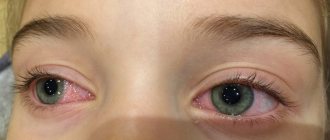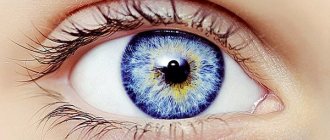Causes
The causes of discomfort in the eyeballs or eyelids can vary, from simple lack of sleep to serious injury.
The list of main factors that can explain to you why your baby’s eyes itch is quite extensive.
Allergy
Often it is the itching felt in the eye area that indicates that the child has an allergy. In addition, the degree of damage to the eyelids and eye tissues, as well as burning in the eyes, depends on the causes of the allergic reaction.
Allergies and stuffy nose - these symptoms mainly appear during seasons when all kinds of plants are in bloom, in apartments where long-haired animals live, or due to infrequent cleaning and the presence of house dust.
Foreign object
If the eye is watery and itchy, the itching may indicate the presence of a foreign object, for example, a speck of dust, a midge, or a grain of sand trapped behind the eyelid.
Such small objects can be difficult to examine and remove, especially in an infant. Foreign bodies cause itching and burning in the eyes, redness of the mucous membrane.
Fatigue and overexertion
If your child has one or both eyes itching, the causes of this symptom can be explained by fatigue and overexertion. Computer and TV screens have the most negative impact on the eyes. In order for children's eyes to rest, mothers need to teach children to take a break when watching cartoons on TV or on the computer.
Obstruction of the lacrimal duct
If you notice that the corners of your baby's eyes are very itchy, the signs may indicate congenital obstruction of the tear duct.
With this problem, the eyes are not moistened with tears and dry out, which is why unpleasant symptoms occur in children.
Conjunctivitis
Red eyelids that are swollen may indicate an infection with conjunctivitis.
Conjunctivitis occurs for various reasons; the child may have an allergy or a virus. Allergies in the form of conjunctivitis occur due to the contact of chemicals or cosmetics with the mucous membrane.
Low-quality toys also provoke allergic conjunctivitis, which makes the corners of the eyes itch.
Wound healing
Redness in the eyes of a child can be observed during the healing period of a wound. In this case, itching appears due to the healing substances produced by the child’s body.
What to do if the lower eyelid is swollen
If you notice that your lower eyelids are swollen, the main thing is not to panic and start by determining the cause. Examine the sore spot carefully and determine whether there is a red swelling on the lower eyelid or whether pain is felt when blinking or pressing. Remember whether the eye has been subjected to mechanical damage, remembering that one eyelid (the damaged one) may swell. When an unpleasant phenomenon is the result of excess fluid, you need to reduce its consumption and remove excess water from the body (with the help of medications or folk remedies).
If the eyelid under the eye is swollen due to minor mechanical damage or an insect bite, the swelling will soon go away; you can speed up the process by using ointment. If the swelling does not go away, you need to show the growth on the eyelid to the doctor to make sure that it is not cancer. If the swelling is caused by changes within the body, you need to consult a doctor. Under no circumstances should the visit be postponed if the lower eyelid is swollen, the eye hurts, or additional symptoms are observed (see above).
Drug treatment
It is possible to treat the disease of patients who find it painful to blink due to edema and swelling only after establishing the cause of the disease and an accurate diagnosis. The therapy is prescribed in a comprehensive manner; as a rule, the following drugs are prescribed:
- a solution of boric acid (5 g of substance per 100 ml of water) and hydrocortisone or tetracycline ointment are used when the eye hurts under the lower eyelid;
- Celestoderm, Levomycetin drops, Prednisolone (these are antibacterial drops that help cure infectious diseases);
- Claritin, Tavegil, Zodak are prescribed for allergic reactions.
We also recommend reading: What to do if your eye is swollen
Note! If the problem is related to regular lack of sleep, an eye cream against puffiness and bags under the eyes will be a good help.
Allergic reaction
Swelling and swelling of the lower eyelid is often allergic in nature. It can appear during the flowering period of plants that cause a reaction, after eating certain foods, contact with animals, etc. Additional signs, besides the fact that the eyelid is swollen and red, indicating an allergic reaction - itchy areas of the skin, the area around the eyes itches. If you have such symptoms, you need to contact an allergist who will identify the allergen and prescribe medications.
To treat allergies in the lower eyelid, antihistamines are used that have a general (tablets) and local effect (drops). The medications listed above cope well with irritation.
Treatment with folk remedies
In folk medicine, there are also known remedies for swelling, puffiness and bags under the eyes. They are unlikely to help get rid of swelling of a pathological origin, but they do an excellent job with swelling of a physiological nature. Here are some of the most popular recipes:
Recipe No. 1
Treatment with strong warm tea. Tea is known as an antiseptic, so it helps well if the eyelids are red, swollen and itchy due to pathogenic flora entering them.
Recipe No. 2
Rubbing with an ice cube (ideal if the ice base is herbal infusions).
Recipe No. 3
If you often work late and every morning you wonder how to quickly remove bags under your eyes and puffiness, remember this recipe. Grate a cucumber, fresh potato or apple. Wrap the resulting mass in gauze and apply to problem areas for a quarter of an hour.
Recipe No. 4
If your eyes are swollen from excess fluid in the body, take half a tablet of furosemide (a diuretic). It is often impossible to increase the dose and use the drug, as kidney problems may occur.
Eye swelling and itching: diagnosis and treatment
For every mother, problems with the health of her child, no matter how old he is, are the biggest problem. If a child complains that his eyes itch and his eyelids swell, mothers try to find out and eliminate the cause that triggered the pathological process as soon as possible.
We will also try to figure out why children’s eyes itch and swell, and what to do about it.
Allergies as the main cause of swelling and itching of the eyes and eyelids
The most common answer to the question of why a child’s eyes are swollen and itchy, and the eyelids are red and swollen is an allergic reaction. There are several types of allergic eye diseases:
- Swollen eye
Spring conjunctivitis.
Most often, the eyelids swell and itch during the warm season, in response to contact with wind-blown pollen from flowering plants.
- Drug-induced conjunctivitis. Eye swelling can be caused by the main component of the drug taken by the child, or one of the excipients.
- Papillary conjunctivitis. A child forced to wear corrective lenses may not tolerate contact with the lens or special solution, which causes swelling, redness and itching of the eyes and eyelids.
- "Dry/tired eye."
The habit of playing computer games for a long time or reading in poor lighting can cause eye fatigue. This allergic reaction manifests itself in the fact that the eyelids swell, and the eyes itch and turn red, and a burning sensation may be felt. - Chronic conjunctivitis. This pathology makes itself felt with every contact with an allergen. It could be a certain food product, animal hair, cosmetic product or household chemicals.
- Allergic rhinitis. Tearfulness and redness of the eyes, as well as swelling and itching of the upper and lower eyelids, are the main accompanying symptoms of allergic rhinitis, both in children and adults.
The best drugs for the eyes
- Visine is a powerful selective blocker of H1 histamine receptors. Contains active levocabastine hydrochloride to suppress allergy symptoms in a matter of days, reduce swelling, redness, itching, and lacrimation. Release form: drops or ampoules. Directions for use: 1…2 drops of the product are instilled into the affected eye twice a day. It is not recommended to use more than 4 days in a row. Can be purchased in pharmacies without a doctor's prescription. The cost of 15 ml is 357 rubles.
- Betaxolol is a lipophilic composition with rapid penetration into the anterior chamber of the cornea. A high concentration in the lower part of the conjunctival sac is observed already 25 minutes after instillation. The hypotensive effect of the drug is aimed at relieving tension, stabilizing eye pressure, and reducing the production of intraocular fluid. Release form: 5 ml drops or 20 ml coated tablets, 30 pcs. Dispensed in pharmacies without a doctor's prescription. Cost: 5 ml drops – 107 rubles, pack of 30 tablets, 20 mg each – 480 rubles.
- Diclofenac is a non-steroidal drug used for eye pain caused by inflammation. The action is aimed at suppressing the synthesis of allergens that provoke the development of inflammation on the cornea of the eye. Diclofenac. Quickly relieves swelling, inflammation, pain. Release form: gel 100 g, ointment 30 g. Price of the drug: gel 100 g – 125 rubles, ointment 30 g – 17 rubles.
Other reasons
To understand why the eyelids of newborns swell, it is necessary to find out whether the baby’s tear-nasal canal is inflamed.
Also, the cause of swelling of the eyelids and eyes in a newborn baby may be the postpartum outflow of fluids. An older child may suffer from itchy and swollen eyes for the following reasons:
Itchy eyes
- Foreign body. While playing, a small child may insert an object under the eyelid, which will cause swelling and redness of the eyes and eyelids.
- Infectious or bacterial conjunctivitis.
An infection on the outer layer of the eyeball causes inflammation of the conjunctival membrane. - Blepharitis. A condition characterized by inflammation of the eyes, peeling and swelling of the eyelids in the morning.
- Chalazion. If a small lump has formed on the eyelid that itches, hurts and turns red, there is a blockage of the meibomian gland. The reasons for the formation of chalazion are violation of hygiene rules and hormonal imbalances.
- Insect bites. Insect bites are the most common causes of swelling and redness of the upper and lower eyelids.
- Barley. The inflammatory process in the eyelash bulbs provokes swelling of the eyelids. The place where the barley forms is itchy and painful….











